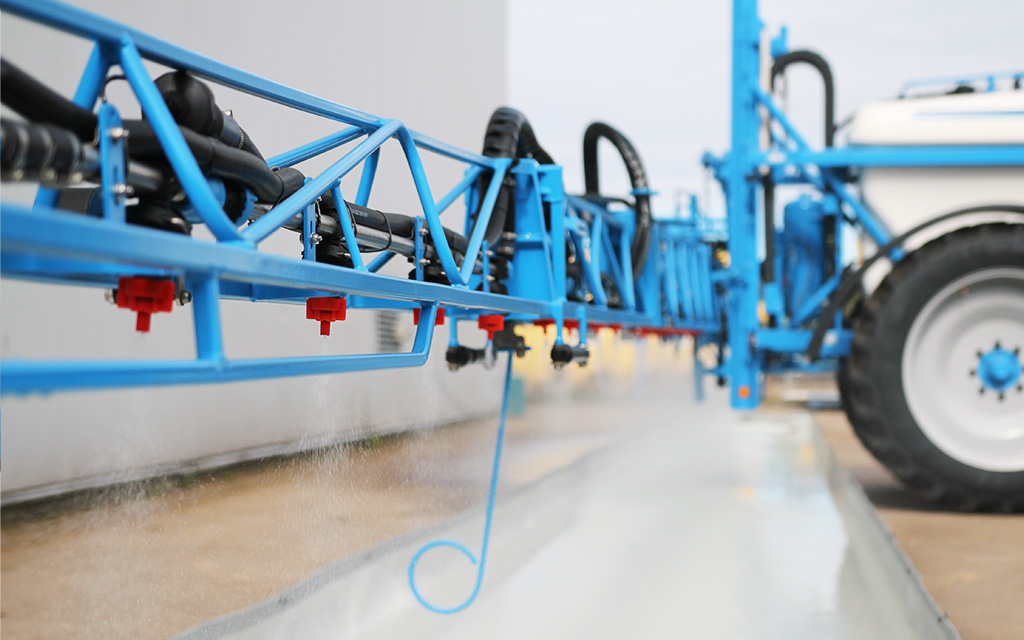
For several years, as the technology of minimum tillage has been gaining popularity, the demand for chemical sprayers in Lithuania has also been growing. Depending on the capabilities of each farm, some choose to purchase new sprayers, while others look to the used equipment market. When buying a used sprayer, it is important not only to carefully inspect its technical condition, but also to make sure that it has a valid technical inspection certificate. As this demand grows, we have started offering farms technical inspection and registration of chemical sprayers from the 2020 season. We inspect and register sprayers throughout Lithuania, and issue the necessary certificate.
We are preparing a checklist of important information, where you will find answers to frequently asked questions and information about what is checked during the inspection.
• How often should the inspection be carried out?
A technical inspection of a sprayer is mandatory and must be carried out every five years, and from 1 January 2020 – every three years, except for new sprayers, which may be used for a maximum of five years after their registration without a technical inspection.
• How do I prepare the sprayer for inspection?
– The sprayer must be in good technical condition;
– The sprayer must be washed inside and out for inspection;
– The main clean water tank is 2/3 full.
• What is checked during a sprayer inspection?
Before performing a technical inspection of sprinklers, we recommend checking the following items, which are checked:
1. Sprayers must operate reliably, ensuring that plant protection products are accurately dosed and distributed.
2. Sprayers must have clear identification marks (manufacturer, model, serial number, year of manufacture), information stickers (use of safety measures, chemical mixer, clean water tank, etc.).
3. The design of the sprayers must ensure safe filling, emptying and cleaning of the sprayer without any leakage and control and the possibility of stopping from the operator's workplace.
4. The sprayer must have a container for clean water for the operator's needs.
5. The sprayer must have a clean water tank so that the inside of the tank and other parts of the sprayer can be washed outdoors and the used water can be sprayed outdoors.
6. The sprayer must have a valve to prevent the solution from leaking out of the tank when repairing the pump and pipelines.
7. The power take-off and input coupling guards must be properly installed without any obvious signs of wear or deformation.
8. The pump performance must be at least 90 percent of the nominal flow specified by the sprayer manufacturer, and there must be no clearly visible pressure pulsations.
9. The safety valve installed in the pump pressure line must operate reliably and ensure the maximum allowable pressure with a deviation of no more than 20 percent.
10. During spraying, the agitator must be in operation to ensure that the solution concentration is uniform throughout the tank. When the PTO speed is at the rated speed and the tank is filled to half its rated capacity, the mixing of the liquid must be clearly visible.
11. The tank and the filling opening closing cover must be tight, and there must be a filtering sieve in the filling opening.
12. The tank must have a clearly visible solution level gauge (scale).
13. If the sprayer is equipped with devices for filling plant protection products and washing their containers provided by the manufacturer, they must be functional.
14. The sprayer filling device, if provided for in the design, must have a non-return valve.
15. All pressure measuring, control and monitoring devices must be functional, leak-proof and comply with the characteristics specified in the technical instructions for the sprinklers.
16. All pressure regulation and control equipment shall ensure a pressure fluctuation of no more than 5% when the pump is operating at rated speed. The pressure shall remain unchanged after the spraying is switched off and on again.
17. The control panel must be located so that the operator can see the instruments and control the sprayer.
18. The pressure gauge scale limits must be greater than the specified maximum pressure developed by the sprayer. The pressure gauge scale division value, when the sprayer's operating pressure is up to 5 bar, must not exceed 0.2 bar.
19. The minimum diameter of the manometer body must be 63 mm., and the manometer error must not exceed ±0.2 bar.
20. Other devices, in particular flow meters used to control the spraying rate under automatic control, may have an error of no more than 5 percent of the measured value.
21. The pipe and hose system must be leak-proof and designed to withstand the maximum permissible operating pressure and to ensure that all nozzles receive a sufficient and even amount of solution.
22. Hoses must not be bent, pinched or cracked. Hoses must be securely fastened during operation and must not obstruct other parts of the sprayer or be sprayed.
23. There must be at least one filter in the suction and pressure lines. The filters must be leak-proof and undamaged. Nozzle filters are not considered pressure line filters. If there are filter clogging indicators, they must be functional.
24. The beam must be straight, unbent and stable in all directions.
25. When the beam is longer than 10 m, there must be a mechanism to lock its position, returning the beam to its original position after contact with an obstacle.
26. The gaps between the nozzles and the sprayed surface must be equal. A slight deviation is permissible: the gaps between the nozzles and the sprayed surface may vary by ±10 cm or 1 percent of the working width of one half of the sprayer.
27. During operation, the sprayer parts must not be sprayed.
28. When the working width of the sprayer is 10 m or more, the ends of the boom must have guards for the edge nozzles, protecting them from damage when the boom comes into contact with the ground surface.
29. The horizontal or vertical folding and lifting devices of the beam must be functional.
30. The beam oscillation and slope compensation damping devices must be operational.
31. It must be possible to switch individual sections of the nozzle boom on or off.
32. All nozzles, their filters and drip-stop valves in the sprayer must be compatible with each other, and the types and sizes of nozzles must not differ.
33. After stopping the supply of liquid to the nozzles, they must not drip after 5 seconds.
34. The error in the performance of each nozzle shall not exceed 5% compared to the average or 15% of the nozzle performance specified by the manufacturer.
35. If the sprayer is equipped with a fan with air supply channels, it must be in good condition and ensure a stable and reliable supply of air flow.
If you have any questions about the sprayer inspection or need assistance, please contact our service department by phone: +370 612 15111 or by email service@agroteka.lt





















